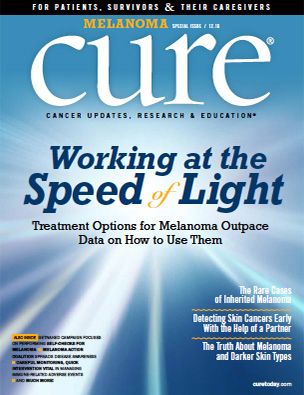Publication
Article
CURE
Keeping Treatment Practices Apace with Recent Scientific Breakthroughs: A Great Challenge to Face
Author(s):
OVER THE PAST FIVE YEARS, the advancements in treating advanced melanoma have been staggering. Eight new drugs have been approved in that time period, including four immunotherapies and four targeted drugs.
As the cancer with perhaps the most mutations, melanoma is eminently treatable with both these types of drugs, and that has made it an excellent testing ground — and success story — when it comes to scientific innovation. In clinical trials, even more drugs are being tested today as treatments for melanoma.
But even before additional drugs reach the market, a challenge — the best kind possible — faces scientists and doctors. Every day, as they treat melanoma patients, they must decide: How do we best use and sequence this host of new drugs in the clinic? All the answers are not in yet, but experts in the field are using their experience to provide guidance. That’s the kind of wisdom that was passed along in a panel discussion hosted this summer by OncLive, a website that is a sister to CURE® magazine and curetoday.com.
In this special issue of CURE®, we present you with coverage of that talk, which outlines current questions in the treatment of advanced melanoma, along with a host of expert recommendations. This information is not just for doctors, but should also be very helpful to patients, who can consider the stage and location of their melanoma and ask informed questions of their health care teams: What mutations are expressed by my melanoma? Should I be treated with targeted drugs or immunotherapy? Should I get immunotherapy after surgery? Should I apply for inclusion in a clinical trial?
Elsewhere in this issue, we remind you that the need for melanoma prevention measures does not end in the winter, when, in many parts of the nation, the heat of the sun is at bay. We discuss a variety of strategies for keeping yourself safe from the sun’s ultraviolet rays.
In a third feature article, we look at the very rare condition of inherited melanoma. While this condition is not treated differently than other melanomas, we discuss the potential merits of knowing about a family history of the disease, and about any mutations that could predispose someone to additional types of cancer.
We round out this issue with articles on the side effects of novel melanoma treatments; some legislative efforts aimed at helping patients; a look at a measure that can increase the efficacy of at-home skin checks; and a report on whether the ultraviolet lamps used in gel manicures increase melanoma risk.
We hope this special issue of CURE® gives you a well-rounded understanding of the issues associated with melanoma, from prevention to treatment to reducing the risk of recurrence. As always, thank you for reading.
MIKE HENNESSY, SRChairman and CEO






